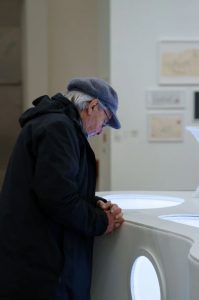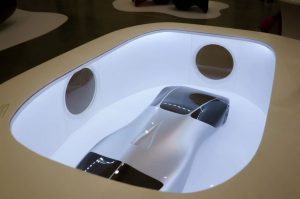
Luigi Colani Exhibition MARTA Herford


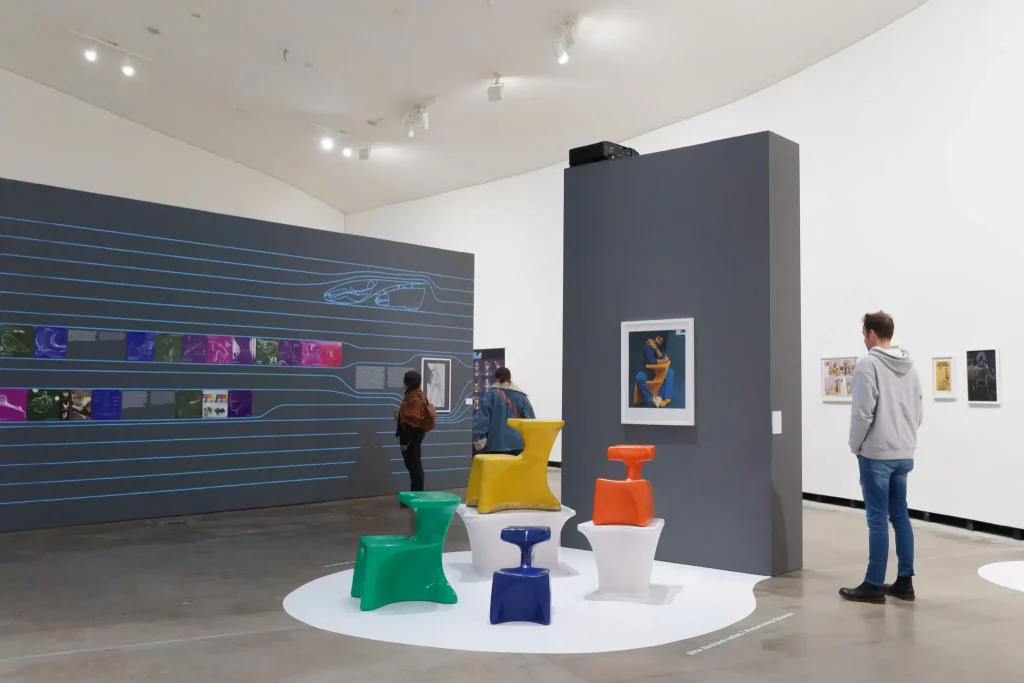
Luigi Colani Exhibition MARTA Herford
- Hashtag(s):
- #Culture
- #Exhibition
- #Product Design
Shapes of the Future – Marta Museum Exhibition
01.12.2024 – 23.03.2025
Luigi Colani was a visionary who challenged the rigid design norms of his era, introducing fluid, organic forms that redefined functionality and aesthetics. His work, often perceived as futuristic and unconventional, was deeply rooted in his biodesign philosophy—taking inspiration from nature to create objects that not only looked dynamic but were also ergonomically optimized for human interaction.
Guest Curators
Tobias Henschen & Julian Puszcz (Designbüro Zweieckig)
Prof. Tim Brauns (TH OWL)
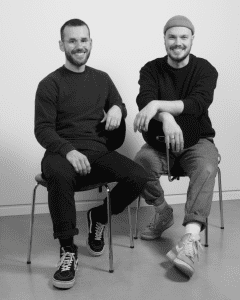

Together with Prof. Tim Brauns from the Ostwestfalen-Lippe University of Applied Sciences, Designbüro Zweieckig took on the design and curation of the exhibition, aiming to showcase Colani’s visionary work within the striking architecture of the Marta Museum, giving visitors a fresh perspective on his legacy. We spoke to Zweieckig studio about the journey of bringing Colani’s world to life inside the iconic Frank Gehry-designed museum, and they gave us some insight about Colani, and the curation process.
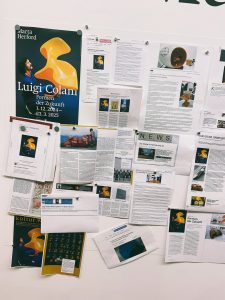
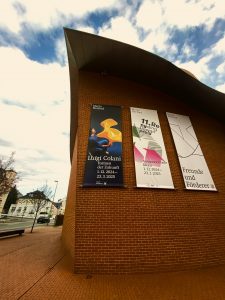
A Local Connection with Global Impact
“For us, this exhibition was a unique opportunity to dive into exhibition design—an exciting discipline within interior architecture that combines storytelling, space, and visitor experience,” says Henschen. Beyond the appeal of designing an exhibition, Colani’s strong connection to the Ostwestfalen-Lippe region made the project particularly meaningful. “He spent many years here, drawing inspiration from the local furniture industry while also leaving a lasting impact with his visionary ideas.”
The exhibition came together in an organic way. “Through contacts in the furniture industry, Marta Herford reached out to Prof. Tim Brauns, who had a personal connection to Colani,” explains Puszcz. “Tim then brought us in as the ‘younger generation’ to collaborate on the exhibition, allowing us to contribute fresh perspectives while learning from those who had direct experience with Colani’s work and legacy.”enriching for us.”

A Treasure Hunt for Design Icons
With a career as prolific as Colani’s, choosing the right exhibits was no small feat. “One of the biggest challenges was identifying the most significant pieces from the thousands of objects he designed,” says Henschen. “Since there is no central registry documenting his complete body of work and where each piece is located, we often had to conduct extensive research.”
This detective work paid off in unexpected ways. “For example, this is how we discovered a truck body that had never been exhibited before—it was covered in dust and tucked away in a warehouse,” Henschen shares. However, some key objects remained elusive. “Of course, there are still objects we would have loved to showcase but couldn’t, simply because their whereabouts remain unknown. This includes several vehicles and even an airplane, which visitors can at least see as a model in the exhibition.”
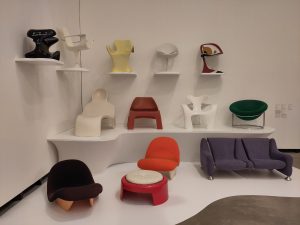
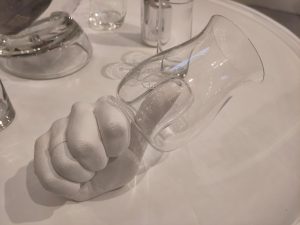
Thematic Areas
The remarkable breadth of Colani’s work demanded a structured approach to the exhibition. To fully capture his diverse contributions, Designbüro Zweieckig divided the exhibition into thematic areas, allowing visitors to navigate freely while gaining a comprehensive understanding of his wide-ranging impact across various fields.
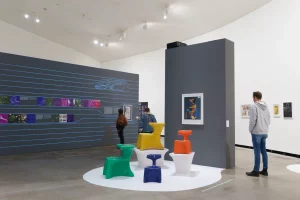
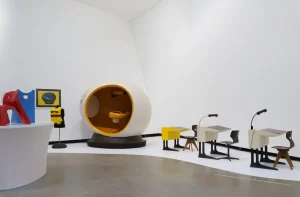
Bring Your Own Colani
Another highlight of the exhibition is an interactive space that invites visitors to engage directly with Colani’s work. Here, guests can not only experience the comfort and ergonomics of his seating furniture firsthand but also contribute to the exhibition itself.
As part of the “Bring Your Own Colani” campaign, visitors are encouraged to bring everyday objects designed by Colani from their own homes, along with the personal stories behind them. These contributions will be integrated into the exhibition, gradually forming a dynamic and evolving display that highlights how Colani’s designs continue to be a part of daily life in the region.
The exhibition is open at the Marta Museum in Herford until March 23, 2025.
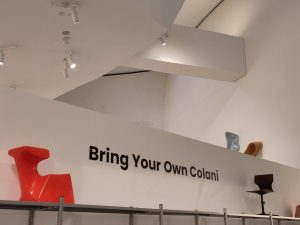
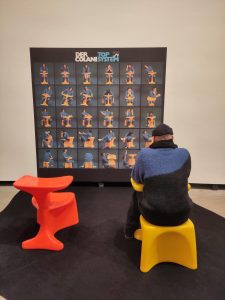
Archival TV recordings
A particularly striking element of the exhibition is a dedicated pavilion that shifts the focus from Colani’s designs to the man behind them. This space presents not only his professional journey but also contrasting facets of his personality—both his public and private selves. Archival TV recordings reveal the loud, polemical Colani, known for his provocative and confrontational nature. In contrast, intimate video footage, filmed by a close confidant, offers a rare glimpse into his quieter side—showcasing moments of deep concentration as he worked, away from the spotlight.
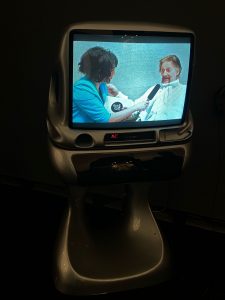
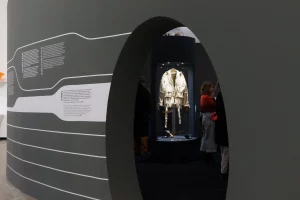
What Would Colani Think?
Asked how Colani himself might have reacted to the exhibition, Puszcz laughs. “Hellen Westerhof, Colani’s last master student, told us that Colani would likely have something to complain about, as he always did. However, she believes he would definitely be thrilled to see his work presented in such a diverse way.” She also praised the curators for contextualizing the objects rather than merely displaying them. “She appreciated the fact that we didn’t just display the objects ‘as is,’ but instead placed them in context with each other, emphasizing the story behind them.”
A Man Ahead of His Time.. and Computers
For all his futuristic visions, Colani was skeptical of computers. “He never used CAD software or a PC for his own design work,” says Henschen. “He believed that computers imposed limitations and forced a predefined design language onto the user.” Instead, he worked entirely by hand, sculpting his ideas in clay before creating larger fiberglass prototypes.
And yet, his ideas were often prophetic. “Some of his visions from Ylem have already become reality—he foresaw home offices and video calls, for instance,” notes Puszcz. “Perhaps he would see artificial intelligence as a natural progression, or maybe he would reject it outright. Who knows? He might not even find it innovative enough.”
Colani Meets Gehry
With Frank Gehry’s curving, sculptural spaces as a backdrop, the exhibition had to find a balance between Colani’s bold forms and the museum’s own architectural identity. “Colani once noted that Gehry designs ‘from the outside in,’ while he himself worked ‘from the inside out,’” says Puszcz. “Our exhibition bridges these two approaches.”
Rather than overwhelming visitors, the display elements take a subtler approach. “The pedestals echo Colani’s design language, integrating with the museum’s architecture while giving each piece the presence it deserves,” explains Henschen. “Unlike in Colani’s time, we also used digital tools in our design process. While he worked with fiberglass, we explored a mix of textiles and wood to reinterpret his aesthetic in a contemporary way.”

Reintroducing Colani to a New Generation
More than just a retrospective, the exhibition invites visitors to see Colani’s work in a new light. “We hope that visitors not only gain an appreciation for the vast scope of Colani’s work but also get a sense of the visionary mind behind it,” says Henschen. “His futuristic approach is still striking today, and many of his ideas feel as if they were conceived for a time that has yet to come.”
For the curators, the process of working on the exhibition deepened their own understanding of Colani. “At first, when you start learning about Colani, you’re often faced with the loud, extravagant persona who would criticize his fellow designers in interviews,” Puszcz reflects. “However, as we delved deeper into his design process and spoke with people who knew him, we started to see there was more to him than just his public image.”
With its thoughtful curation and immersive storytelling, the exhibition offers a rare glimpse into the mind of a designer who never fit into any one era. As Henschen puts it, “Some of his designs still seem ahead of their time, others appear almost nostalgic, and some exist entirely outside of any specific time period—reinforcing the uniqueness of his creative vision.”
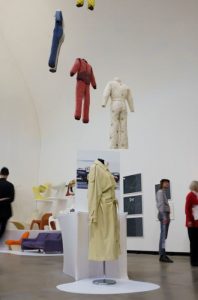
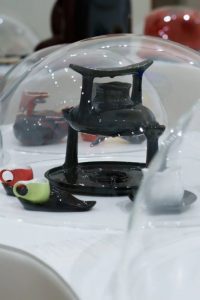
Get to know more about the designers through: https://www.zweieckig.com/luigi-colani-formen-der-zukunft/
